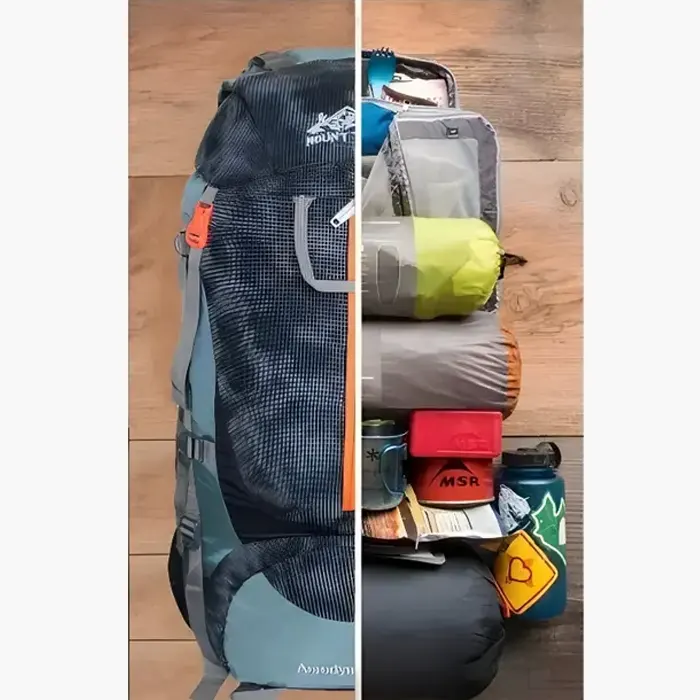What are the aspects to consider, when buying a Rucksack?
When buying a rucksack, whether for your 1-day hike OR for your week-long trek, there are a number of strong factors to consider to ensure you get the best fit for your needs. Here’s a detailed breakdown on what to look for when buying a rucksack:

Durability & Material:
It is all about, what you need the Rucksack for. Be it a day’ hike OR a long trek or expedition you have planned. There are some basics you will have to look for:
- The size & the weight: Generally, the Nylon OR Polyestser materials are used for making a Rucksack, the main thing to consider is how heavy the rucksack is when empty. For a day’s hike, if you are considering a rucksack of 30 to 40 ltrs the ideal weight should be under 1 Kg and for your week-long treks the weight should be 1.5 to 2 kgs for 65 to 75 liters. A larger capacity may feel bulkier, so make sure to not choose too big unless the need of the extra space is there.


- Fit and comfort: The padded, breathable back panel helps in to keep the pack off your back for ventilation. The shoulder straps and hip belt should be adjustable and if chest strap is also included then it will be perfect for your overall weight management.


- Padding: Thick, high-density foam mesh padding on the shoulder straps, hip belt, and back panel will provide extra comfort, especially during extended use.
- Zippers and buckles: opt for YKK or other high-quality zippers that are less likely to break or jam. Also look for high quality solid buckles so with time-to-time use, those should not get broken easily.


Compartments:
- Main Compartment & opening: Usually, in current scenario the trending rucksacks that are available with top opening of main compartment which comes with zip closure first and drawstring to tie the final closing knot above it following with a top flap cover buckle closure… which will be all good against front zipper opening as your stuff might not well organized in front opening zipper rucksack as whenever there will be need to open the front opening rucksack, be cautious of the stuff in it that it should not fall off with sudden opening jerk.



- Pockets: External pockets on both sides can be a game-changer. You may check for side mesh pockets for water bottles, top and front zip pockets for quick-access items, and internal compartments to separate smaller gear, if internal compartments are not there, try buying a rucksack which comes with bar tagged loops on front or on sides to hang extra small accessory like important keychains, trekking pole, ice axe or even a water bottle if it has a finger loop over cap. There are some rucksacks which comes with bottom zip compartments to arrange the shoes OR slippers which are really helpful and mostly such options are available only in large capacity rucksacks only which are more than 60 liters. A rucksack with small zipper pockets on waist straps both sides, that can act as a quick accessing pockets and can be used for most important essentials to access like phone, keys, energy bars, lip balms OR sunscreen etc. Lastly, there are rucksacks available with the provision of hydration pack installation for which there is an extra sleeve or a pocket is provided inside main compartment and a loop hole to take the hydration pack’s pipe out.






Overall, if you like things compartmentalized, look for multiple compartments as explained above OR if you prefer more free space, fewer compartments may suit you better.


Weather Resistance:
- Rain cover: Mostly Rucksacks built material like Nylon OR Polyester are water resistant material only. Moreover, it doesn’t matter where you are planning the trek for OR for whatever duration and regardless of the weather forecasting, a rain cover is must to have…some rucksacks do come with non-detachable rain cover and some are available with separate rain covers.

Color and Design:
Consider your personal taste and whether you want your bag to blend in or stand out.
Price vs. Value:
Lastly, it’s important to balance price and quality. A high-quality rucksack can be an investment, but you if you are looking to invest light on your first rucksack then at least look for:
- Warranty: Check if the manufacturer offers a warranty or repair services. High-end rucksacks often come with a lifetime guarantee.
- Discounts: Look out for sales, but ensure you’re not sacrificing essential features.
Choosing the right rucksack isn’t just about looking at the features—it’s about finding a balance between function, comfort, and style. Take the time to assess your needs, try on different bags, and consider the long-term durability and comfort. With the right rucksack, you’ll be prepared to take on any adventure with ease and confidence.
